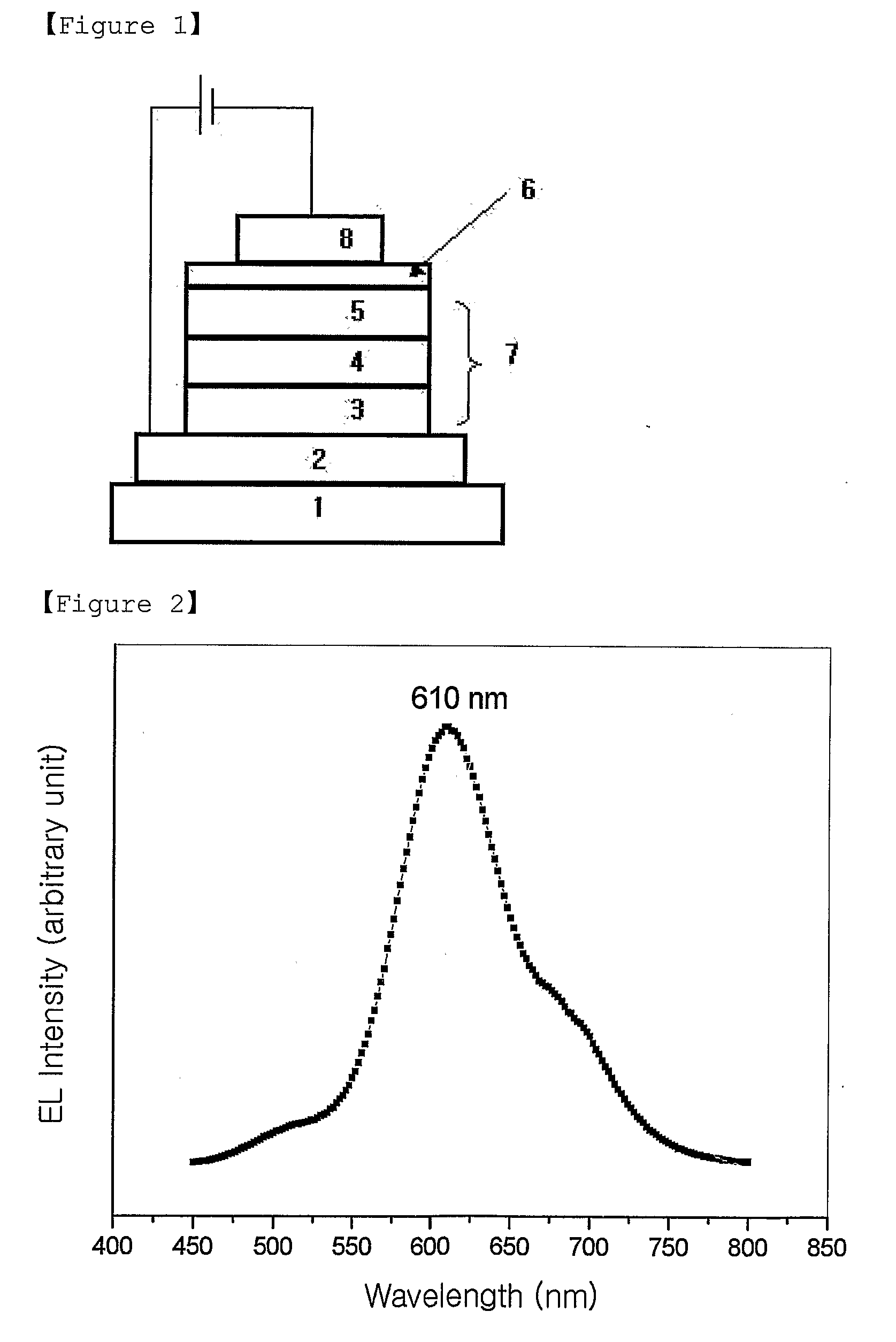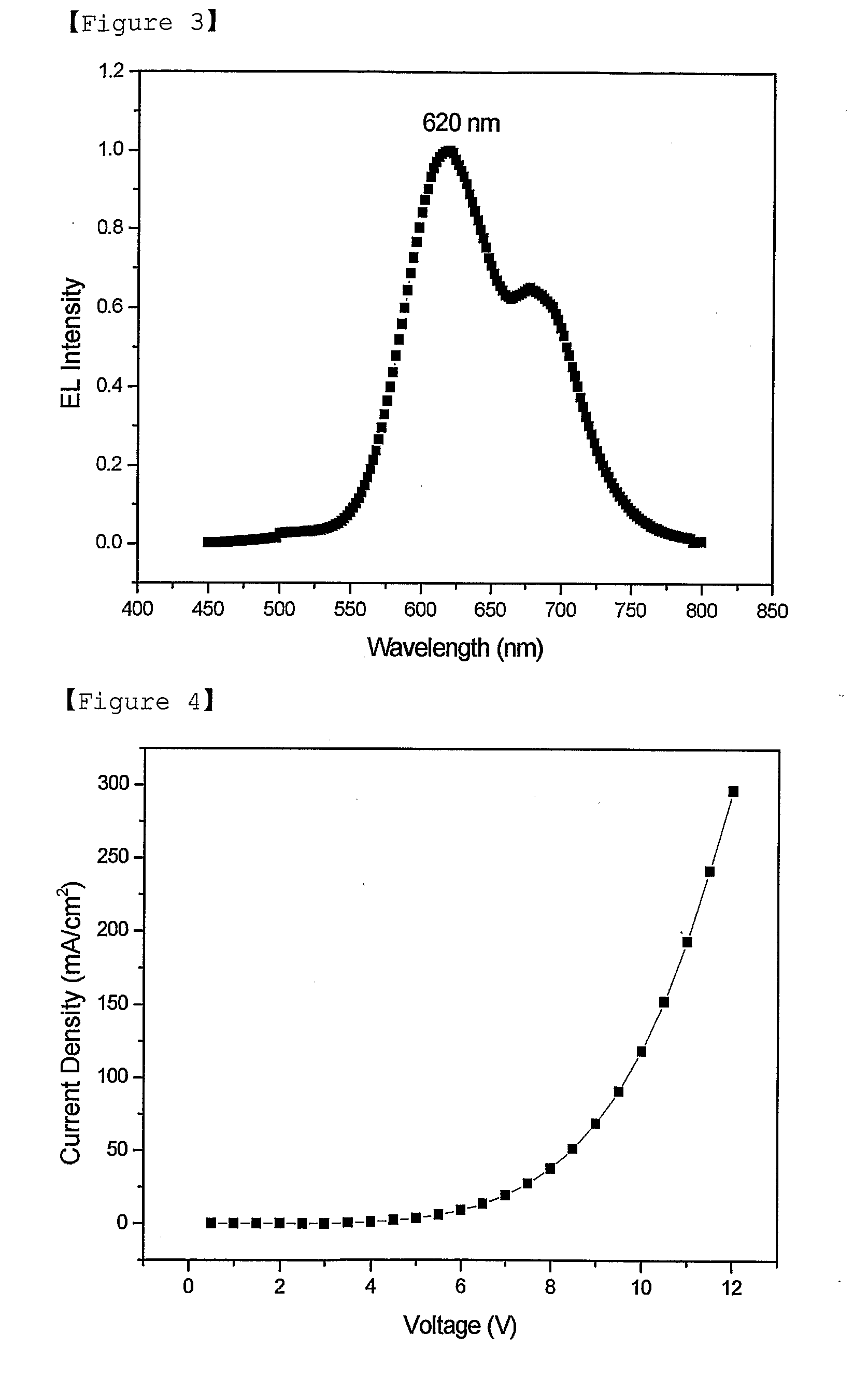Red Electroluminescent Compounds And Organic Electroluminescent Device Using The Same
a technology of red electroluminescent materials and organic electroluminescent devices, which is applied in the direction of organic semiconductor devices, organic chemistry, natural mineral layered products, etc., can solve the problems of not being able to achieve high-performance electroluminescent devices, not being able to achieve and not being easy to achieve. high-efficiency red light-emitting characteristics
- Summary
- Abstract
- Description
- Claims
- Application Information
AI Technical Summary
Benefits of technology
Problems solved by technology
Method used
Image
Examples
example 1
Synthesis of Compound 256
[0059]
[0060] Subject Compound 256 is synthesized in the steps shown in Chemical Formula 5.
[0061] The 0.5 g portion (3.1 mmoles) of Compound 31, which is a tetrahydroquinolone derivative, 0.55 g (3.7 mmoles) of 1H-benzotriazole-1-methanol, and 1.5 g of molecular sieves (4 Å) are melted in 8 mL of THF, and heated at 50-60° C. until 1H-benzotriazole-1-methanol is melted completely. The heated material is stood still at a room temperature for 20 hours, after which molecular sieves are sifted and THF is blown off in order to obtain Compound 32.
[0062] To 10 ml of THF solution in which 2-methylene-1,3-propanediyl)-bis(trichlorosilane) (33) is dissolved, 34 mL of methyl lithium (1.6 M in diethylether) is added slowly under nitrogen. The mixture is stirred at a room temperature for 12 hours, and 10 mL of methanol is added slowly. The mixture is stirred for 10 minutes, and extracted with ether producing 0.52 g of Compound 33.
[0063] The 0.5 g portion (3.1 mmoles) of...
example 2
Synthesis of Compound 248
[0066]
[0067] Subject Compound 248 is synthesized in the steps shown in Chemical Equation 6.
[0068] The 0.5 g portion (3.1 mmoles) of Compound 42 and 0.54 mL (3.1 mmoles) of methallyltrimethylsilane (43) are dissolved in methylene chloride, and 3.1 mL of SnCl4 (1.0 M in dichloromethane) is added slowly to the mixed solution at −78° C. And 0.37 g of Compound 44 is obtained in the same method as that of synthesis of Compound 34 in Example 1. Then, 0.29 g of Compound 45 is obtained in the same method as that of synthesis of Compound 35 in Example 1 by using 0.37 g (1.22 mmoles) of Compound 44 synthesized in the above.
[0069] The 0.29 g portion (0.89 mmole) of Compound 45, 0.3 g (0.89 mmole) of Compound 36, and 0.44 mL (4.45 mmoles) of piperidine are dissolved in 12 mL of ethanol, and precipitates are obtained by reacting the mixed solution in the same method as that of synthesis of Compound 256 in Example 1. Then, these precipitates are recrystallized in methyle...
example 3
Synthesis of Compound 260
[0070]
[0071] Subject Compound 260 is synthesized in the steps shown in Chemical Equation 7.
[0072] The 0.70 g portion of Compound 52 is obtained by using 0.50 g (3.1 mmoles) of Compound 31 and 0.54 mL (3.1 mmoles) of 2,7-dimethyl-5-silaspiro[4,4]-nona-2,7-diene (51) in the same method as that of synthesis of Compound 33 in Example 1. Then, 0.65 g of Compound 53 is obtained by using 0.70 g (2.07 mmoles) of Compound 52 thus obtained in the same method as that of synthesis of Compound 35.
[0073] Precipitates are obtained as the reaction product by using the mixed solution of 0.31 g (0.85 mmole) of Compound 53, 0.28 g (0.85 mmole) of Compound 36, and 0.42 mL (4.25 mmoles) of piperidine in 10 mL of ethanol in the same method as that of synthesis of Compound 256 in Example 1. These precipitates are recrystallized by using ethyl acetate, and 0.31 g (synthetic yield of 53%) of Compound 260, which is the subject compound, is obtained.
PUM
| Property | Measurement | Unit |
|---|---|---|
| Temperature | aaaaa | aaaaa |
| Temperature | aaaaa | aaaaa |
| Temperature | aaaaa | aaaaa |
Abstract
Description
Claims
Application Information
 Login to View More
Login to View More - R&D
- Intellectual Property
- Life Sciences
- Materials
- Tech Scout
- Unparalleled Data Quality
- Higher Quality Content
- 60% Fewer Hallucinations
Browse by: Latest US Patents, China's latest patents, Technical Efficacy Thesaurus, Application Domain, Technology Topic, Popular Technical Reports.
© 2025 PatSnap. All rights reserved.Legal|Privacy policy|Modern Slavery Act Transparency Statement|Sitemap|About US| Contact US: help@patsnap.com



